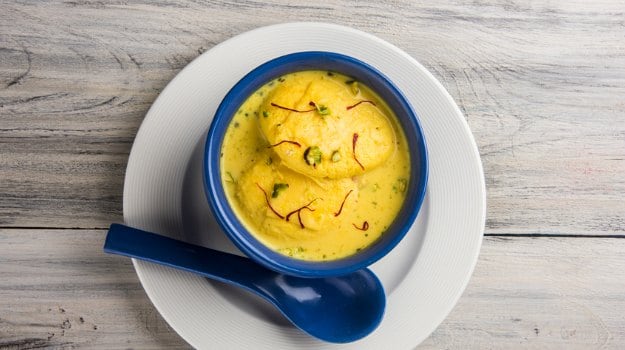In my early years in Mumbai, my Bengali friends and I would make a beeline for the Durga Puja pandals here and hog on the food served at the food stalls set up. Deep fried delights of cutlets, chops, rolls, luchi alur dom and Moghlai porathas. Supremely overpriced and of rather flaccid quality but who cared? We were reveling in our Bengaliness after all. There would be curries and main courses on offer too but it always made sense to go for the food cooked in front of you.
Over the years, Mumbai began to have a few good Bengali restaurant options and one didn't have to wait for that one time of the year to feast on Bengali food outside of home. Just as one didn't have to wait for that one time of the year to buy notun jaama.
Then I got to know the organisers of the Bandra Durga Pujo thanks to my blog. They welcomed me to their fold and there I was, once again serving bhog and then eating with the volunteers, just as I once did in my growing up days in Kolkata, and just as my late father had in the UK in the 1970s.
So what is bhog? (the 'o' is pronounced as in 'bore')
Most community Durga Puja pandals serve lunch during the Pujo days. Both In Kolkata as well as outside. Some serve it on Ashtami, which is the biggest day of the Pujo. Some on all the 5 days.

In the big pujos, bhog is served free to all who come, just as it is in the langars of Sikh Gurudwaras. The food is sponsored by chanda or contributions by members and by corporate sponsorship. In some private pujos, such as in our apartment back home, the meals on days apart from on Ashtami are ticketed and not on the house. Folks like my mother would find this to be a welcome respite as they could take a break from the kitchen on the pujo days.
What all dishes does a typical bhog include?
The bhog is usually vegetarian and the cornerstone of it is the khichudi. If you talk to any Bengali about this, they will tell you with misty eyes that the magic of a bhoger khichudi can't be replicated at home. The romantic and devout at heart will tell you that this is thanks to Ma Durga's blessings. The more logical might tell you that the large quantities in which the khichudi is slow cooked over 3-4 hours adds something to the taste that is difficult to achieve in a home kitchen.
Sometimes it is best to enjoy food rather than analyzing it too much.

Occasionally, the khichudi could be substituted with a mishti pulao. On the side you will have bhajas for sure - begun, alu or fulkopi. Then mixed vegetable dishes such as labra (wet) and chyachra (drier). Dishes that fish and meat loving Bengali happily lap up during the Pujos. This is the only time of the year when most of us don't protest about the presence of pumpkins and greens in our meals. A sweet and sour chutney follows as a palate cleanser and then payesh (kheer) and mishti to end the meaIn big community pujos, you queue up and are served the meal at counters, and then find a corner to eat in. In smaller pujos, tables are laid and these become sit down meals. There is a religious ritual to the bhog. There is a small of amount food which is cooked and offered to the Goddess, often by the women in the organizing committee of the pujos.

Meanwhile, an area is set up beside the pujo pandal where cooks toil over big dekchis, cooking food to be served to the visitors to the pandals. The food offered to the Goddess is then mixed into this so that the food served to all, across religion, caste and community, is blessed.
By the way, most of us don't really turn vegetarian during the pujos. There are certain community pandals where fish might be served on Nabami and meat on Doshami, as it is in my building in Kolkata. This, perhaps for the financial implications, is more of a ticketed affair.
The food fun doesn't end with the bishorjon or the end of the pujos. Bijoya follows, where you go to the houses of your neighbours, friends and family to offer your respect and best wishes. To mainly eat the yummy food laid out actually!
Didn't I tell you? To us Bengalis, it is all about the food.About the author:Kalyan loves to eat and he loves to talk about all that he eats. His wife urged him to start writing about it, otherwise she would have to hear it all. He blogs as 'finelychopped' and has won numerous awards for his blog.
Disclaimer:The opinions expressed within this article are the personal opinions of the author. NDTV is not responsible for the accuracy, completeness, suitability, or validity of any information on this article. All information is provided on an as-is basis. The information, facts or opinions appearing in the article do not reflect the views of NDTV and NDTV does not assume any responsibility or liability for the same.







